( Log In ) Log In is for TREC Teachers & Researchers only
  |
| Steve_Marshall |
 Jun 19 2005, 04:12 AM Jun 19 2005, 04:12 AM
Post
#1
|
 TREC Teacher    Group: TREC Team Posts: 78 Joined: 27-April 05 Member No.: 12 |
NOTE: As of 7 pm Alaska Daylight Time on 6/18/05, we are free and moving again!!
Now back to our regularly scheduled journal entries: 6/16/05 : Still Sunny, Still in the 30s, Still Stuck Improvising While We Wait Realizing we are going to be stopped longer than expected, the scientists began to think of ways we could collect at least SOME information with what we had to deal with. Part of Joseph Ortiz’s (Kent State) research was to do some trawling for plankton. Since we weren’t moving, what could we do? The ship does have an intake valve for seawater, so as long as there wasn’t any mixing or contamination, how could we use that to simulate a trawl? First, we need to determine the rate of intake. How could we do that? If we have a container of known volume, and we time it takes to fill that container, we can figure out how long it would take to collect the volume of water normally obtained from a regular trawl. To keep it short, we had to go through a lot of calculations and unit analysis, which quickly made me think of when I go over this procedure in class. I get that inevitable question of, “When are we ever going to use this?” Well this served as a perfect example. With calculations complete, we were ready to take some samples once we had the opportunity. Making the Calculations Joseph Ortiz doing the number crunching to determine how long we need to collect sea water to match the volume that would pass through a net during a normal plankton tow.  Preparing the Lab 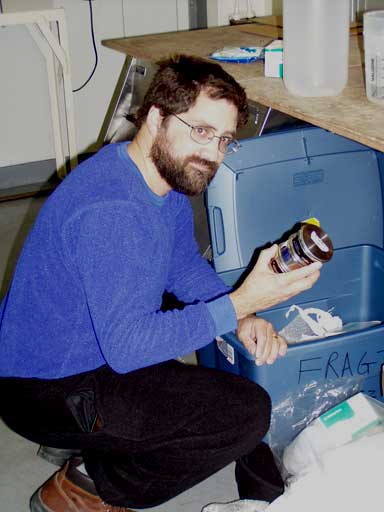 Ortiz is getting out some small sediment sieves. These sieves are like metal screens with different size openings, so each one collects a specific size range of sediments when you put a sample through them. Other scientists were doing similar improvisions or preparations to make their time as productive as possible; Leonid Polyak, from Ohio State University, was checking out some microscopes and other equipment for readiness, core liners continued to be built, and helicopter missions took on a new importance. Checking the Microscope 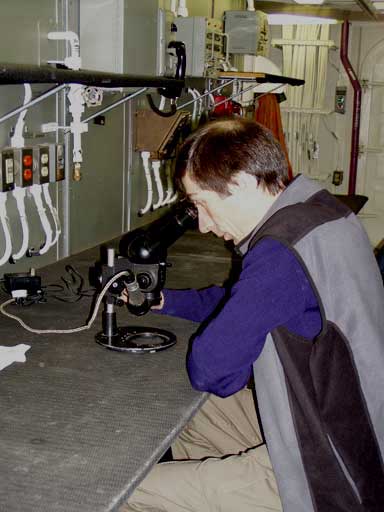 Leonid Polyak from Ohio State University is testing the microscope in preparation for the sediments he will be studying CTD Profiler 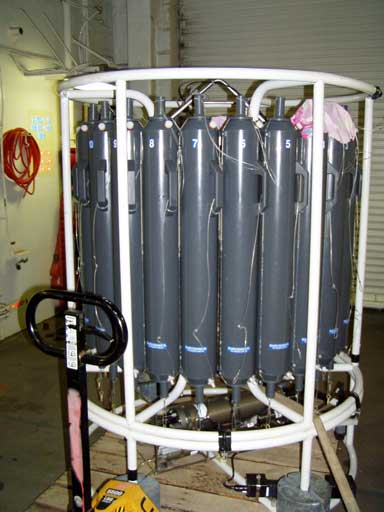 This is a picture of a CTD Profiler, which measures the ( C)onductivity (salinity), (T)emperature, and (D)epth of the water from the surface to however far it is sent down. The long tubes that circle the equipment are called Niskin bottles, which open and close to collect water samples at different depths. One Way or Another, We’re Going to Get Some Samples!  A picture of the helicopter taking off to search for dirty ice…Ice with sediment trapped in it. (photo by Greg Cutter) Sampling of sediment-filled ice, “dirty ice,” was going to be a secondary project on this cruise, but now it was becoming our best bet to obtain some samples while we waited to get moving again. Although we did have some setbacks with that too since conditions need to be right for helicopter flights, we did get a few flights to go out today. The first flight had Greg Cutter on it from Old Dominion University. While he didn’t spot any good areas, he did get some good pictures of our predicament in the ice (It was his shots I posted in yesterday’s journal). The second flight, with Guillaume St-Onge from Canada, WAS successful in collecting some sediment samples from the ice. These samples were brought back to the ship, and if nothing else, we at least have SOMETHING to work with. Other missions are scheduled throughout our cruise (I’m scheduled to go on one!:)), so hopefully we will get even more samples later. The pictures taken from Guillaume’s flight are shown below: Grabbing a Sample  Guillaume St-Onge collects samples of sediment-filled ice Not to Worry 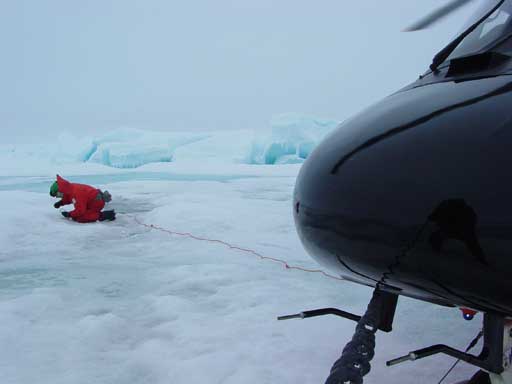 As shown here, Guillaume is safely tethered to the helicopter just in case.. Something Interesting? 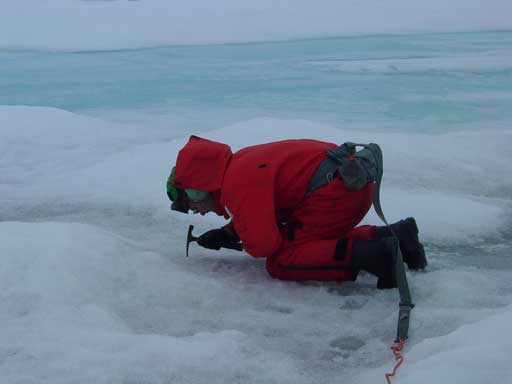 Guillaume gets up close and personal with the ice Joining the Fun 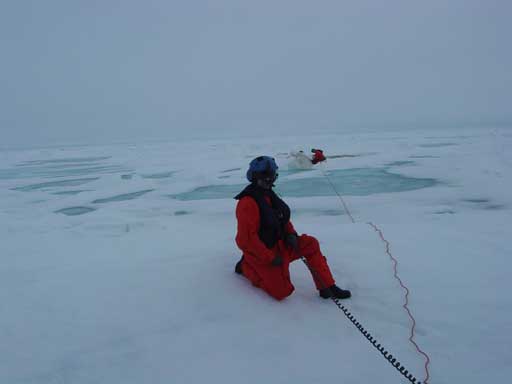 Good depth perspective with member of the helicopter crew in foreground, and Guillaume in the background at the sample site One…(Make That “Many”)…Small Step(s) 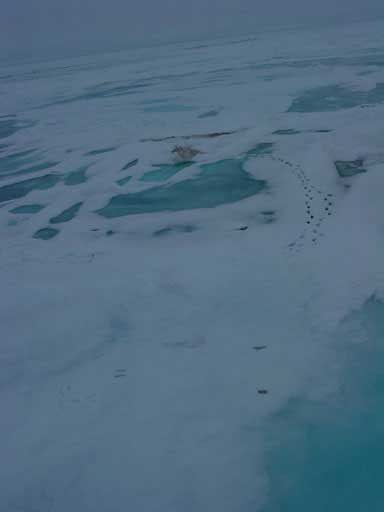 Footprints leave a trace of the path taken to the sample site Trying to Move After the helicopter missions were done for the day, the captain decided to power up the engines for the first time in awhile to see what we could do. While it was exciting to see all the water being churned up and flowing around, we didn’t make much progress. We’d try again another time. What A Show!  Part of the ship’s crew looking at the water being churned up by the ship’s propellers in an attempt to break free of the ice Shaken and Stirred  I wonder what category these man-made rapids would be That’s a BIG Ice Cube!  This thing was bouncing around by a big ice cube…You’d need a pretty big glass to hold this one! Tourist Shot  Picture of me standing at the stern (back) of the ship with the propeller-driven river flowing in the background(photo by Ray Savicke) Realizing we’d be immobile at least a little longer, and completing most of the things we could do to stay productive, we turned to other things to fill our time. This included things like playing cards and attending talks some of the scientists have signed up to give about their current research. Pick a Card…Any Card 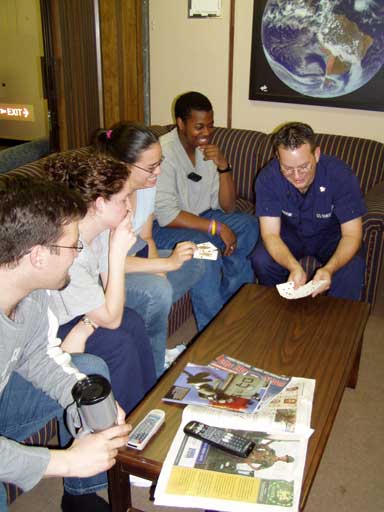 Public Affairs officer Cangemi helps fill the down-time by showing card tricks to some of the science crew. Despite it All, Still Keeping Busy While others seem to be starting to have trouble finding out how to keep themselves busy, I don’t seem to have that problem. With only one hour of internet time twice a day, and that connection being very slow, I have to be ready to use my time as efficiently as I can. While that seems to be hectic enough, what added to it today and tonight was a problem with our outgoing e-mail which had usually been going out 24 hours a day. Now it wasn’t going out at all. This meant that I had to franticly use my internet time to see if I could communicate with the ARCUS staff (Ben Wade especially), who have been great in helping to get my pictures posted, by way of other e-mail connections through the internet. With quick tests via instant messages and test e-mails, I was able to determine how to keep the posts and pictures flowing even if they would be restricted to the internet times. Stressn’ Out 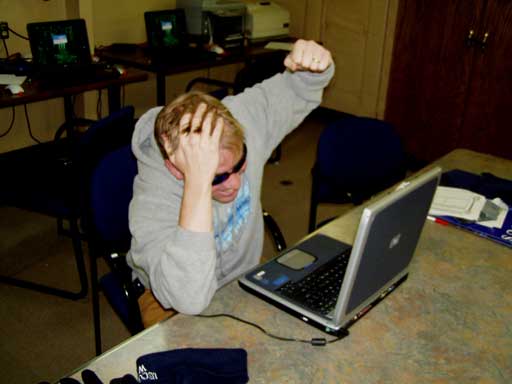 No e-mail?! What do you mean, “No e-mail?!” …Ready to take it out on the computer After all that quick stressing, the ship’s e-mail problem was corrected soon after. Although that made our backup plan unnecessary, it is nice to know what we can do if the problem comes up again. The main reason I have gone into some detail about this problem is to again give it as an example of how we use the scientific method every day to solve problems. You come up with ideas of what might work to solve a problem, you test those ideas, and you respond depending on the results of those tests. I did it with the e-mail problem, the scientists are doing it to adjust to our circumstances, the ship’s crew is doing it with the problem of being stuck, and so on. The next time you wonder when you’re going to use science or the scientific method, just look at your everyday life. |
| Robert_Oddo |
 Jun 19 2005, 03:02 PM Jun 19 2005, 03:02 PM
Post
#2
|
 TREC Teacher    Group: TREC Team Posts: 165 Joined: 27-April 05 Member No.: 8 |
Keep that boat moving!!!!
Bob |
  |
1 User(s) are reading this topic (1 Guests and 0 Anonymous Users)
0 Members:

|
NSF Acknowledgment & Disclaimer | Time is now: 5th November 2024 - 04:21 PM |
Invision Power Board
v2.1.7 © 2024 IPS, Inc.








